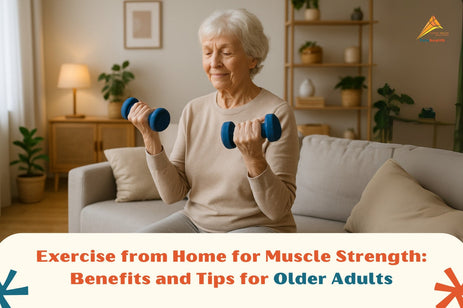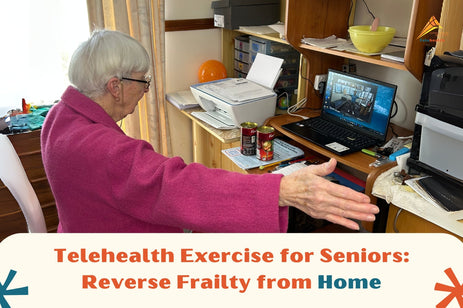
As we age, maintaining joint health becomes more important than ever — especially for seniors living with arthritis. Arthritis doesn’t have to mean slowing down; the right type of exercise can strengthen joints, ease stiffness, and help manage pain effectively.
At Summit Health Solutions, our Telehealth Exercise Program is designed specifically for seniors. With guided movement sessions you can do from home, you’ll stay active, connected, and in control of your mobility.
Why Exercise Matters for Joint Health
Movement is medicine for your joints. Regular exercise keeps the cartilage in your joints nourished by encouraging the flow of synovial fluid — the “lubricant” that reduces friction and stiffness.

For seniors with arthritis, staying active helps:
-
Reduce inflammation and swelling
-
Improve range of motion
-
Strengthen the muscles supporting your joints
-
Enhance balance and prevent falls
According to the Arthritis Foundation Australia, gentle physical activity is one of the most effective, evidence-based ways to reduce arthritis pain and improve function.
Exercising with Arthritis: Finding the Right Balance
Many people worry that movement will worsen joint pain. In reality, inactivity is what often leads to more stiffness and weakness. The key lies in choosing low-impact exercises that are joint-friendly and sustainable.
Here are safe options to include in your weekly routine:
1. Range-of-Motion Exercises
These gentle stretches help maintain flexibility and reduce joint pain and stiffness. Try slow neck rotations, shoulder rolls, or gentle ankle circles each day.
2. Strength Training
Light resistance training helps protect the joints by strengthening surrounding muscles. Using resistance bands or light weights two to three times per week can significantly improve support around arthritic joints.
3. Aerobic Exercise
Low-impact activities like walking, water aerobics, or cycling can improve circulation and reduce inflammation markers. The World Health Organization (WHO) recommends at least 150 minutes of moderate physical activity weekly for older adults.
4. Balance and Coordination Exercises
Gentle balance work — such as standing on one leg or practicing heel-to-toe walking — helps reduce fall risk and maintain stability.
Overcoming Joint Pain and Stiffness Safely
Living with arthritis often means managing days of discomfort, limited mobility, and unpredictability. However, movement — when done correctly — is one of the safest and most effective ways to ease joint pain and stiffness. The key is learning how to exercise in a way that supports your joints, not stresses them.
When you begin a new exercise routine, it’s important to start slow, listen to your body, and focus on controlled, gentle movements. Activities that move your joints through their full range of motion — like light stretching, water exercises, or tai chi — can gradually loosen tight areas and improve circulation. Even five to ten minutes a day can make a noticeable difference in how flexible and comfortable your joints feel.
A physiotherapist or exercise physiologist can tailor activities to your condition — which is exactly what Summit Health Solutions’ Telehealth Exercise Program offers. Our team ensures each movement supports your goals and comfort level, without strain or risk.
The Science Behind Exercise and Arthritis Pain Relief
Research from the University of Sydney’s Institute for Musculoskeletal Health shows that regular movement can improve mobility and reduce arthritis pain by lowering inflammation and improving circulation.
Exercise also triggers the release of endorphins — natural painkillers — while helping regulate sleep, mood, and energy levels. Over time, this consistent movement strengthens your confidence and independence.
If you’re curious how daily activity adds years (and quality) to life, check out our related post:
🌟 Daily Movement = Longer Life: Here’s Why
How Telehealth Makes Exercising Easier for Seniors
One of the biggest challenges for seniors with arthritis is accessibility — traveling to a clinic or gym can be difficult, especially during flare-ups or poor weather. That’s why Summit Health Solutions created a way for you to stay active safely and conveniently from home.
With Summit Health Solutions’ Telehealth Exercise Program, you can participate in guided, joint-friendly exercise sessions online. Each class is delivered by our qualified clinicians via live video, ensuring you maintain correct form and follow safe, evidence-based routines designed to support joint health.
Our program runs in structured two-month rounds, each with a unique movement theme that keeps sessions fresh, engaging, and progressively challenging. Every class is carefully designed by licensed physiotherapists to accommodate a wide range of abilities — making it suitable for seniors with arthritis and other mobility concerns.
Program Highlights
-
🩺 Structured, professionally designed sessions: A consistent exercise framework developed by health experts, with different movement themes introduced every two months.
-
👩⚕️ Real-time guidance from licensed physiotherapists: Physiotherapists lead every session live, helping participants perform movements safely and effectively.
-
🤝 Supportive group environment: Enjoy the motivation, accountability, and sense of connection that comes from exercising alongside others who share similar goals.
👉 Learn more about how our Telehealth Exercise Program keeps seniors active and engaged — wherever they are.
Tips for Staying Consistent
Improving joint health is about consistency, not intensity. Here’s how to stay on track:
-
Track your progress with a journal or app
-
Join us in our virtual exercise groups for motivation
-
Celebrate small milestones (like improved range of motion or balance)
And remember: it’s okay to rest during flare-ups — what matters is returning to your routine when your body’s ready.
FAQs About Exercising with Arthritis
1. Can exercise make arthritis worse?
No — when done correctly, exercise helps relieve joint pain and stiffness. The key is choosing low-impact, tailored movements under professional guidance.
2. What type of exercise is best for arthritis pain relief?
Gentle activities such as swimming, walking, and stretching are ideal. These promote joint pain relief without adding stress or pressure to affected areas.
3. How often should seniors with arthritis exercise?
Aim for at least 150 minutes of moderate activity per week, as recommended by the Department of Health and Aged Care Australia. Spread it over most days for steady benefits.
4. What if I feel pain while exercising?
Stop if the pain is sharp or lasts more than a couple of hours. You may need to adjust your intensity or rest before resuming. Seek professional guidance from your exercise physiologist.
5. Is it safe to join an online exercise program with arthritis?
Yes — when supervised by trained clinicians. Programs like Summit Health Solutions’ Telehealth Exercise Program are designed for seniors with arthritis, ensuring exercises are safe, adaptive, and effective.
Move Better, Live Better
Arthritis may be part of your story — but it doesn’t define your future. With the right support, you can move more freely, reduce pain, and regain confidence in your body.
At Summit Health Solutions, we’re committed to helping seniors stay strong, independent, and active through personalised Telehealth Exercise Programs.
Take the first step toward stronger joints today — and discover the power of movement from home.























